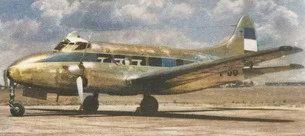Foreign Aircraft in Postwar Argentine Aviation

North American Northrop 8A-2. Foto Revista LIFE.
Northrop Model 8A-2

Model 8A-2
Version for Argentina. Equipped with fixed landing gear, ventral gun position, and powered by an 840 hp (626 kW) Wright R-1820-G3 Cyclone engine. 30 units built.
The Northrop A-17, a development of the Northrop Gamma 2F, was a two-seat, single-engine monoplane attack bomber built in 1935 by the Northrop Corporation for the U.S. Army Air Corps. (Source: Wikipedia)
.
Cyclone Wright R-1820-E. Museo Smithsonian del Espacio Aéreo. corriente continua



North American NA-16
Curtiss Hawk 75H

North American Aviation NA-16 was the first trainer aircraft built by North American Aviation, Inc., and marked the beginning of a line of American training aircraft that would eventually exceed 17,000 units.
Developed into:
-
North American BT-9
-
T-6 Texan
-
North American P-64
-
CAC Wirraway
The NA-16 was a single-engine, low-wing monoplane with tandem open cockpits and fixed landing gear. It was powered by a 400 hp air-cooled Wright Whirlwind radial engine. Although primarily of metal construction, the rear fuselage was fabric-covered.
The NA-16 first flew on April 1, 1935, and was sent to the United States Army Air Corps for evaluation as a basic trainer. The Army accepted the trainer for production but requested several significant modifications. These included replacing the Wright engine with a Pratt & Whitney R-1340, enclosing the cockpits, and adding fairings to the landing gear. The modified NA-16 was redesignated by North American as the NA-18, with production models entering Air Corps service as the North American BT-9 (NA-19).
In Australia, the Commonwealth Aircraft Corporation (CAC) produced 755 units of a modified version of the NA-16, known locally as the Wirraway, between 1939 and 1946.
Additionally, two NA-16 trainers were supplied to the Imperial Japanese Navy Air Service for evaluation in 1938, designated as KXA1 and KXA2.
(Source: Wikipedia)



Curtiss Hawk 75



Gloster Meteor F4

100 units were exported to Argentina, and they saw action on both sides during the 1955 revolution, with one aircraft lost on September 19, 1955.
The Argentine Air Force ordered 50 Meteor F.4s in May 1947, which included 50 ex-RAF aircraft and 50 newly built units. Deliveries began in July of that year. The Meteor remained in service until 1970, when the last aircraft were replaced by the Dassault Mirage III.


Brístol F.2B
Aeronaves militares y civiles en 1948. Fuente: "La Aeronautica Nacional al servicio del pais"

Avro Lincoln



Vickers "Vickings" cargo aircrafts


Bristol Tipo 170 Cargo plane

Douglas DC-4

De Havilland "Dove"

Canberra Mk 62
Surviving Examples

The Argentine Air Force received 27 Model 139W/WAA aircraft.

The only complete surviving B-10 is on display at the National Museum of the United States Air Force at Wright-Patterson Air Force Base, near Dayton, Ohio. The aircraft is painted to represent a B-10 used during the 1934 Alaska Flight. It is actually an export version sold to Argentina in 1938.
The aircraft survived as a ground crew training platform, and the Argentine Air Force continued using it to train personnel well into the 1960s. The U.S. Air Force Museum conducted an extensive search for surviving B-10 parts and eventually discovered this aircraft.
In 1970, the incomplete fuselage was formally donated by the Argentine government to the United States government, in a ceremony attended by the U.S. ambassador.
The aircraft was restored by the 96th Maintenance Squadron (Mobile), Air Force Reserve, at Kelly Air Force Base, Texas, between 1973 and 1976, and was put on display in 1976.
(Source: Wikipedia)







No comments:
Post a Comment